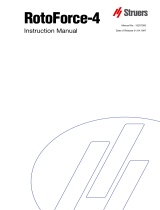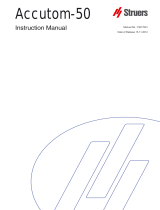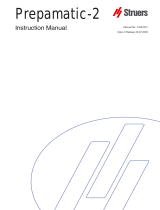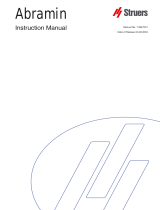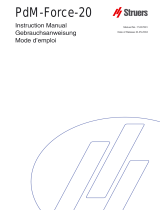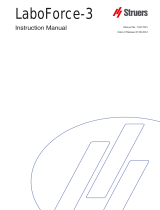La page est en cours de chargement...

Epovac
Instruction Manual
Gebrauchsanweisung
Mode d’emploi
Manual No.: 14357001
Date of Release 19.06.2007
Updated 2016.07.01

Epovac
Instruction Manual
Instruction Manual
A
lways state Serial No and Voltage/frequency if you have technical questions or when ordering spare parts.
You will find the Serial No. and Voltage on the type plate of the machine itself. We may also need the Date
and Article No of the manual. This information is found on the front cover.
The following restrictions should be observed, as violation of the restrictions may cause cancellation of
Struers legal obligations:
Instruction Manuals: Struers Instruction Manual may only be used in connection with Struers equipment
covered by the Instruction Manual.
Service Manuals: Struers Service Manual may only be used by a trained technician authorised by Struers.
The Service Manual may only be used in connection with Struers equipment covered by the Service Manual.
Struers assumes no responsibility for errors in the manual text/illustrations. The information in this manual is
subject to changes without notice. The manual may mention accessories or parts not included in the present
version of the equipment.
The contents of this manual is the property of Struers. Reproduction of any part of this manual without the
written permission of Struers is not allowed.
A
ll rights reserved. © Struers 2007/2016.
Struers
Pederstrupvej 84
DK-2750 Ballerup
Denmark
Telephone +45 44 600 800
Fax +45 44 600 801

Epovac
Instruction Manual
Epovac
Safety Precaution Sheet
To be read carefully
before use
1. The operator should be fully aware of the use of the apparatus
according to the Instruction Manual. The apparatus must be placed in
an adequate working position.
2. Never use vacuum chambers other than the ones delivered from
Struers.
3. If any cracks or a visible colour change occur in the vacuum chamber it
must be replaced immediately.
Replace the vacuum chamber every second year.
4. Do not leave the chamber under vacuum and filled with impregnation
and / or gluing material fumes for longer than 1 hour.
5. Clean the vacuum chamber with a soft damp cloth and common
household detergent or ethyl alcohol. Do not use Acetone or similar
solvents.
6. Use only consumables which are suitable for vacuum impregnation in a
PVC chamber.
Impregnation and / or gluing materials must be handled with care. See
the Instruction Manual and Material Safety Data Sheet for the resin.
The equipment should only be used for its intended purpose and as detailed in the Instruction Manual.
The equipment is designed for use with consumables supplied by Struers. If subjected to misuse, improper
installation, alteration, neglect, accident or improper repair, Struers will accept no responsibility for
damage(s) to the user or the equipment.
Dismantling of any part of the equipment, during service or repair, should always be performed by a qualified
technician (electromechanical, electronic, mechanical, pneumatic, etc.).


Epovac
Instruction Manual
1
User’s Guide
Table of Contents Page
1. Getting Started
Description.........................................................................................2
Checking the Contents of Packing.....................................................2
Consumables kit (EPOSU) .......................................................2
Getting Acquainted with Epovac ........................................................3
Installation..........................................................................................4
Connection.........................................................................................4
Epovac with Built-in Air Ejector (EPOMA).................................4
Epovac without Built-in Air Ejector (EPOCA)............................4
2. Operation
Preparing the Impregnation................................................................5
Check vacuum chamber...........................................................5
Impregnation......................................................................................5
3. Reference Guide
Hints...................................................................................................6
Hardening...........................................................................................6
Gluing.................................................................................................6
Maintenance.......................................................................................7
Technical Data...................................................................................7
Air supply (only EPOMA)..........................................................7
Vacuum connection (EPOCA) ..................................................7
Dimensions...............................................................................7

Epovac
Instruction Manual
1. Getting Started
Epovac is a vacuum impregnation apparatus, especially designed for
embedding and impregnation of porous materials. Epovac is suitable
for gluing specimens to slides for the preparation of thin sections.
The apparatus consists of a sturdy, compact metal cabinet with a
cylindrical embedding chamber of PVC. The impregnation liquid, e.g.
Struers Epofix, is supplied through a disposable tube. The tube is led
through a ball joint and it is therefore very easy to distribute the liquid
to the individual mounting cups.
Description
Using ø25 mm mounting cups, 9 specimens can be embedded at the
same time. As the embedding chamber is large (diameter 134mm,
height 100 mm), also large specimens can be impregnated and
embedded.
The bottom of the embedding chamber is made of polypropylene so
that spilled impregnation liquid does not stick.
Epovac comes in 2 models, with built-in air ejector (to be supplied
with compressed air 4.5-6 bar) or without air ejector (to be connected
to an external vacuum pump).
The Epovac model without air ejector can be used with most external
vacuum pumps.
In the packing box you should find the following parts:
Checking the Contents
of Packing
1 Epovac basic unit
1 Vacuum chamber, ø134 mm, height 100 mm
1 Cover
1 Pressure rod
2 Snap holders for pressure rod
1 Hose clip in holder
1 Allen key 2.5 mm
1 Allen key 5 mm
2 Rubber plugs with Ø4 mm center hole
Consumables kit (EPOSU) 80 Beakers
80 Polyethylene hoses
80 Wooden stirrers
2

Epovac
Instruction Manual
Take a moment to familiarise yourself with the location and names of
the Epovac components.
Getting Acquainted
with Epovac
c Vacuum chamber
d Seals
e Cover before operation
f Impregnation hose
g Hose clip
h Pivot joint of the cover
i Rubber plug
j Vacuum valve
k Vacuum meter
l Stand
3

Epovac
Instruction Manual
Epovac does not require any special place, however, the apparatus
should not be placed in direct sunlight, as the PVC vacuum chamber
is UV sensitive.
Installation
NB As impregnation liquids like epoxy are common, the apparatus
should only be operated where ample ventilation is possible, e.g.
in a fume cupboard.
Connection The built-in air ejector enables a vacuum of 90%. This model must
be supplied with compressed air (4.5-6 bar) by means of the hose
supplied with the apparatus:
Epovac with Built-in Air Ejector
(EPOMA)
Insert the connecting tube with fitting in the quick coupling on the
rear of the apparatus.
Shorten the hose to an adequate length.
Mount the hose on the compressor.
Connect the apparatus to a vacuum pump by means of the hose,
supplied with the apparatus:
Epovac without Built-in Air
Ejector (EPOCA) Mount the connecting tube on the fitting on the rear of the
apparatus.
Mount the hose clip and tighten it.
Shorten the hose to an adequate length.
Mount the hose on the vacuum pump.
Take care that the hose does not have any sharp bends as these will
delay the application of resin. If a longer hose is required it is
recommended to choose a hose with a larger inside diameter, in
order to secure a sufficient flow.
4

Epovac
Instruction Manual
2. Operation
Place the clean and dry specimen in a suitable mounting cup. If
there is more than one, place them symmetrically around the
center of the embedding chamber.
Preparing the Impregnation
Check that the vacuum chamber and the cover before operation
are not cracked or have fissures, or they might implode when
exposed to vacuum.
Check vacuum chamber
Check that the seals are clean and undamaged.
Mount the vacuum chamber.
Mount the cover.
Press the impregnation hose through the rubber plug. Put the
impregnation hose through the hose clip and place the rubber
plug in the pivot joint of the cover.
Tighten the hose clip and open for the compressed air (model
with pump) or start the vacuum pump (model without pump). Set
the vacuum valve to max. The actual vacuum can be read on the
vacuum meter.
NB Before impregnation the specimens should be cleaned and
degreased.
For embedding, Struers manufactures a number of mounting cups
that can be used without releasing agent.
When the specimens have been under vacuum for an appro-
priate time - from a couple of minutes for not very porous
specimens up to half an hour for very porous specimens - the
impregnation can begin:
Impregnation
Place the beaker with the ready-mixed impregnation liquid in the
stand. Check that the hose is near the bottom of the beaker, or
air may be sucked into the system and create splashing in the
vacuum chamber.
Turn the hose so that it points down into one of the mounting
cups and open slowly for the hose clip, until the impregnation
liquid runs in an appropriate flow.
When the specimen is covered with impregnation liquid, turn off
the flow, move the hose to the next mounting cup and open the
hose clip. Go on like this until all mounting cups have been filled
up.
Close the hose clip and turn the vacuum valve to min.
Remove the vacuum chamber with cover and leave the
specimens for hardening.
5

Epovac
Instruction Manual
3. Reference Guide
If 2 or 3 component resins like Epofix are used, it is important that
the resin is not heated in order to obtain quicker hardening. The resin
will quickly become highly viscous that results in poor impregnation.
Hints
Avoid using larger quantities of embedding material than about 20 ml
as the heat generation then may become too large with a bad
impregnation as a result.
At too high vacuum some of the components in the epoxy evaporate
and it looks as if it boils. This can be avoided by reducing the
vacuum with the valve.
If Epovac is not going to be used anymore the same day, the
specimens can remain in the apparatus for hardening. When the
specimens have hardened, the impregnation hose can also be re-
moved without any risk of leaving resin on the hose clamp or in the
pivot joint.
Hardening
If the apparatus is going to be used again, the hose with rubber plug
is removed from the cover. Keep the rubber plug, as it can be used
again. Take care not to spill impregnation liquid on the pivot joint or
the hose clip, especially if it is a 2- or 3-component liquid which
hardens.
Any spilled impregnation liquid must be removed at once with a
suitable detergent.
Apply a suitable amount of resin to the specimen. Usually one
drop is enough.
Gluing
Place the specimen with the glued surface up, and place a glass
slide upon the specimen.
Mount the pressure rod with rubber plug in the pivot joint of the
lid.
Start the vacuum pump, open the compressed air, and set the
vacuum valve to max.
Place the pressure rod on the glass slide and rub. When the
specimen is firmly stuck to the slide, set the vacuum valve to
min.
Remove the slide with glued sample.
6

Epovac
Instruction Manual
7
Clean the vacuum chamber with a soft damp cloth and common
household detergent or ethyl alcohol.
Do not use Acetone or similar solvents
Drain the air filter periodically by loosening the valve screw
underneath the apparatus.
When no more liquid emerges, retighten the valve screw.
Compressed air: 4.5-6 bar
Air quality: 0.3 micron filtered, oil free
Consumption of compressed air: 12.5 l/min
Hose connection: ø1/4"
Vacuum (at compressed air 6 bar): -860 mbar (-655 mm Hg)
Hose connection: 5/16"
Outer dimensions:
Width 320 mm
Depth 290 mm
Height 240 mm
Weight: 4 kg
Vacuum Chamber:
Inner diameter ø130 mm (effective ø110 mm)
Inner height 100 mm
Maintenance
Model with built-in air ejector
(EPOMA)
Technical Data
A
ir supply (only EPOMA)
Vacuum connection (EPOCA)
Dimensions

Epovac
Instruction Manual
8
Gebrauchsanweisung
Geben Sie bitte bei technischen Anfragen oder bei der Bestellung von Ersatzteilen immer die Seriennumme
r
und die Spannung/Frequenz an. Diese Angaben finden Sie auf dem Typenschild des Geräts, bzw. der
Maschine.
Beachten Sie bitte die nachstehend genannten Einschränkungen. Zuwiderhandlung kann die Haftung der
Firma Struers beschränken oder aufheben:
Gebrauchsanweisungen: Eine von der Firma Struers veröffentlichte Gebrauchsanweisung darf nur in
Zusammenhang mit den Struers Geräte benützt werden, für die diese Gebrauchsanweisung ausdrücklich
bestimmt ist.
Wartungshandbücher: Ein von der Firma Struers veröffentlichtes Wartungshandbuch darf nur von
ausgebildeten Technikern benutzt werden, die von Struers dazu berechtigt wurden. Das Wartungshandbuch
darf nur in Zusammenhang mit dem Struers Gerät benützt werden, für das dieses Wartungshandbuch
ausdrücklich bestimmt ist.
Struers übernimmt für Irrtümer in Text und Bild der Veröffentlichungen keine Verantwortung. Wir behalten
uns das Recht vor, den Inhalt der Gebrauchsanweisungen und Wartungshandbücher jederzeit und ohne
Vorankündigung zu ändern. In den Gebrauchsanweisungen und Wartungshandbüchern können Zubehör
und Teile erwähnt sein, die nicht Gegenstand oder Teil der laufenden Geräteversion sind.
Der Inhalt der Gebrauchsanweisungen und Wartungshandbücher ist Eigentum der Firma Struers. Kein Teil
dieser Gebrauchsanweisung darf ohne schriftliche Genehmigung von Struers reproduziert werden.
A
lle Rechte vorbehalten © Struers 2007/2016
Struers
Pederstrupvej 84
DK-2750 Ballerup
Dänemark
Telefon +45 44 600 800
Fax +45 44 600 801

Epovac
Gebrauchsanweisung
9
Epovac
Sicherheitshinweise
Vor Gebrauch
sorgfältig lesen
1. Lesen Sie bitte die Gebrauchsanweisung ausführlich vor Gebrauch des
Gerät. Das Gerät muß arbeitsgerecht aufgestellt werden.
2. Nie andere Vakuumkammern als die von Struers gelieferte verwenden.
3. Entstehen Risse oder sichtbare Verfärbungen in der Vakuumkammer
muss die Vakuumkammer direkt ausgetauscht werden. Die
Vakuumkammer muss jedes zweite Jahr ausgetauscht werden.
4. Die Vakuumkammer nicht länger als 1 Stunde mit Imprägnierung
und/oder Kleber unter Vakuum lassen.
5. Reinigen Sie die Vakuumkammer mit einem weichen, feuchten Tuch
und handelsüblichem Reinigungsmittel oder mit Ethanol. Nutzen Sie
kein Azeton oder ähnliche Produkte.
6. Benutzen Sie nur Verbrauchsmaterialien, die für die Verwendung im
Vakuum in einer PVC-Kammer geeignet sind. Imprägnierungs-
und/oder Klebematerialien müssen mit Vorsicht behandelt werden.
Beachten Sie bitte die Sicherheitsdatenblätter und die
Gebrauchsanweisungen der jeweiligen Produkte.
Das Gerät darf nur für seinen vorgesehenen Anwendungszweck und wie in der Gebrauchsanweisung
beschrieben verwendet werden.
Für die Benützung der Geräte bzw. der Maschinen sind die Verbrauchsmaterialien von Struers vorgesehen.
Falls unzulässiger Gebrauch, falsche Installation, Veränderung, Vernachlässigung, unsachgemäße
Reparatur oder ein Unfall vorliegt, übernimmt Struers weder die Verantwortung für Schäden des Benutzers,
noch für solche am Gerät.
Die für Kundendienst und Reparatur erforderliche Demontage irgendwelcher Teile des Gerätes bzw. der
Maschine sollte immer nur von qualifiziertem Fachpersonal (Elektromechanik, Elektronik, Pneumatik usw.)
vorgenommen werden.

Epovac
Gebrauchsanweisung
10
Gebrauchsanweisung
Inhaltsverzeichnis Seite
1. Zu Beginn
Beschreibung...................................................................................11
Auspacken .......................................................................................11
Satz von Verbrauchsmaterialien (EPOSU).............................11
Epovac kennenlernen ......................................................................12
Aufstellen .........................................................................................13
Anschluß..........................................................................................13
Epovac mit eingebauter Druckluft-Vakuumpumpe
(EPOMA)................................................................................13
Epovac ohne eingebaute Pumpe (EPOCA)............................13
2. Bedienung
Vorbereitung zur Imprägnierung ......................................................14
Vakuumkammer bevor Betrieb kontrollieren...........................14
Imprägnierung..................................................................................14
3. Referenzanleitung
Tips ..................................................................................................16
Härten ..............................................................................................16
Aufkleben.........................................................................................16
Wartung............................................................................................16
Technische Daten............................................................................17
Luftanschluß (nur EPOMA).....................................................17
Vakuumanschluß (nur EPOCA)..............................................17
Dimensionen...........................................................................17

Epovac
Gebrauchsanweisung
1. Zu Beginn
Epovac ist ein Vakuumimprägnierungsgerät, das besonders zum
Einbetten und zur Imprägnierung von porösen Materialien konstruiert
ist. Weiter ist Epovac zum Aufkleben von Proben auf Objektgläser
zur Präparation von Dünnschliffen geeignet.
Beschreibung
Epovac besteht aus einem robusten, kompakten Metallgehäuse mit
einer zylindrischen Einbettungskammer aus PVC. Die
Imprägnierungsflüssigkeit (z.B. Struers' Epofix) wird durch einen
Schlauch zugeführt. Der Schlauch ist durch ein Kugelgelenk geführt,
so daß die Flüssigkeit zu den einzelnen Einbettungsformen sehr
leicht zugeführt werden kann.
Durch Anwendung von Formen von ø25 mm können bis zu 9 Proben
gleichzeitig eingebettet werden. Da die Einbettungskammer groß ist
(ø134 mm, Höhe 100 mm), können auch große Proben imprägniert
und eingebettet werden.
Der Boden der Einbettungskammer besteht aus Polypropylen, so
daß sich verschüttete Imprägnierungsflüssigkeit nicht festsetzt.
Epovac wird in 2 Ausgaben, mit eingebauter Druckluft-Vakuum-
pumpe (zum Anschluß von Druckluft 4,5-6 bar) oder ohne
eingebaute Vakuumpumpe, eingeführt.
Epovac ohne Vakuumpumpe kann mit den meisten externen
Vakuumpumpen verwendet werden.
Folgende Gegenstände sollten in der Verpackung enthalten sein:
Auspacken
1 Epovac Grundeinheit
1 Vakuumkammer, ø134 mm, Höhe 100 mm
1 Deckel
1 Druckstab
2 Schnapphalter für Druckstab
1 Schlauchklammer im Halter
1 Inbusschlüssel 2,5 mm
1 Inbusschlüssel 5 mm
2 Gummistopfen mit Loch
Satz von Verbrauchsmaterialien
(EPOSU) 80 Becher
80 Schläuche aus Polyäthylen
80 Holzspatel
11

Epovac
Gebrauchsanweisung
Nehmen Sie sich einen Augenblick Zeit, um Lage und Namen der
Teile des Epovac kennenzulernen.
Epovac kennenlernen
c Vakuumkammer
d Dichtungsringe
e Deckel
f Imprägnierungsschlauch
g Schlauchklammer
h Drehgelenk
i Gummistopfen
j Vakuumventil
k Manometer
l Ständer
12

Epovac
Gebrauchsanweisung
Epovac fordert keine besondere Stelle, das Gerät sollte aber nicht
direkt im Sonnenlicht angebracht werden, da die Vakuumkammer
aus PVC UV-empfindlich ist.
Aufstellen
NB Da Imprägnierungsflüssigkeiten wie Epoxy normalerweise
verwendet werden, sollte das Gerät nur in Betrieb sein, wo
ausreichende Entlüftung, z.B. in einem Abzugschrank, möglich ist.
Anschluß Die eingebaute pneumatische Pumpe ermöglicht ein Vakuum von
90%. Dieses Modell muß mit Druckluft (4,5-6 bar) durch den
Schlauch, der mit dem Gerät geliefert wird, versehen werden:
Epovac mit eingebauter
Druckluft-Vakuumpumpe
(EPOMA) Den Anschlußschlauch mit Fitting in die Schnellkupplung der
Rückseite des Gerätes einführen.
Den Schlauch bis zu einer passenden Länge abkürzen.
Den Schlauch auf dem Luftkompressor montieren.
Das Gerät an eine Vakuumpumpe mittels des Schlauches, der mit
dem Gerät geliefert wird, anschließen:
Epovac ohne eingebaute Pumpe
(EPOCA) Den Anschlußschlauch auf dem Fitting auf der Rückseite des
Gerätes montieren.
Die Schlauchklammer montieren und festspannen.
Den Schlauch bis zu einer passenden Länge abkürzen.
Den Schlauch auf der Vakuumpumpe montieren.
Dafür sorgen, daß der Schlauch nicht scharf gebogen ist, da das
Zuführen von Harz dadurch verspätet wird. Falls ein längerer
Schlauch notwendig ist, wird empfohlen, einen Schlauch mit einem
größeren Innendurchmesser zu wählen, um eine ausreichende
Strömung zu sichern.
13

Epovac
Gebrauchsanweisung
2. Bedienung
Die reine und trockene Probe in einer passenden Form
anbringen. Falls es mehr als eine Probe gibt, die Proben
symmetrisch um die Mitte der Einbettungskammer anbringen.
Vorbereitung zur
Imprägnierung
Kontrollieren daß die Vakuumkammer und der Deckel keine
Rissen haben, da sonst eine Implosion eintreffen kann. Auch
kontrollieren, daß die Dichtungsringe rein und unbeschädigt sind.
Vakuumkammer bevor Betrieb
kontrollieren
Die Vakuumkammer montieren.
Den Deckel montieren.
Den Imprägnierungsschlauch durch den Gummistopfen drücken.
Den Imprägnierungsschlauch durch die Schlauchklammer
stecken und den Gummistopfen im Drehgelenk des Deckels
anbringen.
Die Schlauchklammer festspannen und den Druckluft andrehen
(Modell mit Pumpe) oder die Vakuumpumpe starten (Modell
ohne Pumpe). Die Vakuumpumpe auf max. einstellen. Das
aktuelle Vakuum geht aus dem Manometer hervor.
NB Vor der Imprägnierung müssen die Proben gereinigt und
entfettet werden.
Zum Einbetten stellt Struers eine Reihe Einbettungsformen her, die
ohne ein Mittel zum Lösen der Proben verwendet werden können.
Wenn die Proben eine passende Zeit unter Vakuum gewesen
sind - von ein paar Minuten für nicht sehr poröse Proben bis zu
einer halben Stunde für sehr poröse Proben - kann mit der
Imprägnierung angefangen werden:
Imprägnierung
Den Becher mit der fertiggemischten Imprägnierungsflüssigkeit
im Ständer anbringen. Dafür sorgen, daß der Schlauch nah am
Boden des Bechers ist, sonst kann Luft in das System
eingesaugt werden und verursachen, daß die Flüssigkeit in der
Vakuumkammer spritzt.
Den Schlauch gegen eine der Einbettungsformen drehen und die
Schlauchklammer langsam lösen, bis die
Imprägnierungsflüssigkeit in einer passenden Menge
herausströmt.
14

Epovac
Gebrauchsanweisung
15
Wenn die Probe mit Imprägnierungsflüssigkeit gedeckt ist, die
Schlauchklammer festspannen, den Schlauch gegen die nächste
Einbettungsform drehen und die Schlauchklammer wieder lösen.
Dieses Verfahren fortsetzen, bis sämtliche Einbettungsformen
gefüllt sind.
Die Schlauchklammer schließen und das Vakuumventil auf min.
einstellen.
Die Vakuumkammer mit Deckel entfernen und die Proben härten
lassen.

Epovac
Gebrauchsanweisung
16
3. Referenzanleitung
Falls 2- oder 3-Komponenten-Harz wie Epofix verwendet wird, ist es
wichtig, daß das Harz nicht aufgewärmt wird, um ein schnelleres
Härten zu erreichen. Sonst wird das Harz schnell viskos, und die
Imprägnierung wird schlecht.
Nicht zu große Mengen von Einbettungsmaterial (mehr als 20 ml)
verwenden. Sonst wird zu viel Wärme erzeugt mit eine schlechte
Imprägnierung zur Folge. Bei zu hohem Vakuum destillieren einige
der Komponenten der Epoxy, und es scheint, als ob die Flüssigkeit
kocht. Dies kann durch eine Reduktion des Vakuums mit dem Ventil
vermieden werden.
Falls Epovac nicht länger an demselben Tag verwendet werden soll,
können die Proben im Gerät zum Härten bleiben. Wenn die Proben
gehärtet haben, kann auch der Imprägnierungsschlauch ohne Risiko
dafür, Imprägnierungsflüssigkeit auf dem Drehgelenk oder dem
Schlauchklammer hinterzulassen, entfernt werden.
Falls das Gerät wieder verwendet werden soll, den Schlauch mit
Gummistopfen vom Deckel entfernen. Den Gummistopfen behalten,
da dieser wieder verwendet werden kann. Aufpassen, daß
Imprägnierungsflüssigkeit nicht auf das Drehgelenk oder die
Schlauchklammer verschüttet wird, besonders falls es eine 2- oder 3-
Komponenten-Flüssigkeit ist, die härtet.
Verschüttete Imprägnierungsflüssigkeit muß mit einem geeigneten
Reinigungsmittel umgehend entfernt werden.
Eine passende Menge Harz auf der Probe anbringen. Normalerweise
reicht ein Tropfen:
Die Probe mit der klebrigen Oberfläche nach oben anbringen
und ein Objektglas auf die Probe anbringen.
Den Druckstab mit Gummistopfen im Drehgelenk des Deckels
montieren.
Die Vakuumpumpe starten, bzw. den Druckluft andrehen, und
das Vakuumventil auf max. einstellen.
Den Druckstab auf der Probe anbringen und die Probe reiben.
Wenn die Probe am Objektglas klebt, was sowohl gefühlt als
auch gesehen werden kann, ist das Aufkleben fertig. Das
Vakuumventil auf min. einstellen.
Das Objektglas mit Probe ausnehmen.
Tips
Härten
Aufkleben
/


